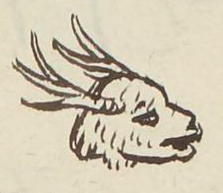Mazatl (MH486r)
This black and white drawing of the simplex glyph for a deer (mazatl) doubles as a personal name, Mazatl, for a man named Diego Mazatl. The deer's head is shown in profile, looking toward the viewer's right. Its coat has a little texturing. It has two antlers showing on one side, and three on the other. The deer's mouth is open slightly.
Stephanie Wood
Mazatl is a day sign in the calendar. The person bearing this name was probably born on a mazatl day. Which number from 1 to 13 would have accompanied this calendrical name is uncertain. By the time of this manuscript (1560) the numbers could drop away inadvertently, or perhaps they were being suppressed by clergy who did not approve of the continued involvement with the autonomous-era, 260-day, divinatory calendar and its religious significance.
Stephanie Wood
diego maçatl
Diego Mazatl
Stephanie Wood
1560
Jose Aguayo-Barragan and Stephanie Wood
calendarios, calendars, days, días, dates, fechas

maza(tl), deer, https://nahuatl.wired-humanities.org/content/mazatl
El Venado
Matrícula de Huexotzinco, folio 483r, World Digital Library. https://www.loc.gov/resource/gdcwdl.wdl_15282/?sp=51&st=image
This manuscript is hosted by the Library of Congress and the World Digital Library; used here with the Creative Commons, “Attribution-NonCommercial-ShareAlike 3.0 License” (CC-BY-NC-SAq 3.0).




